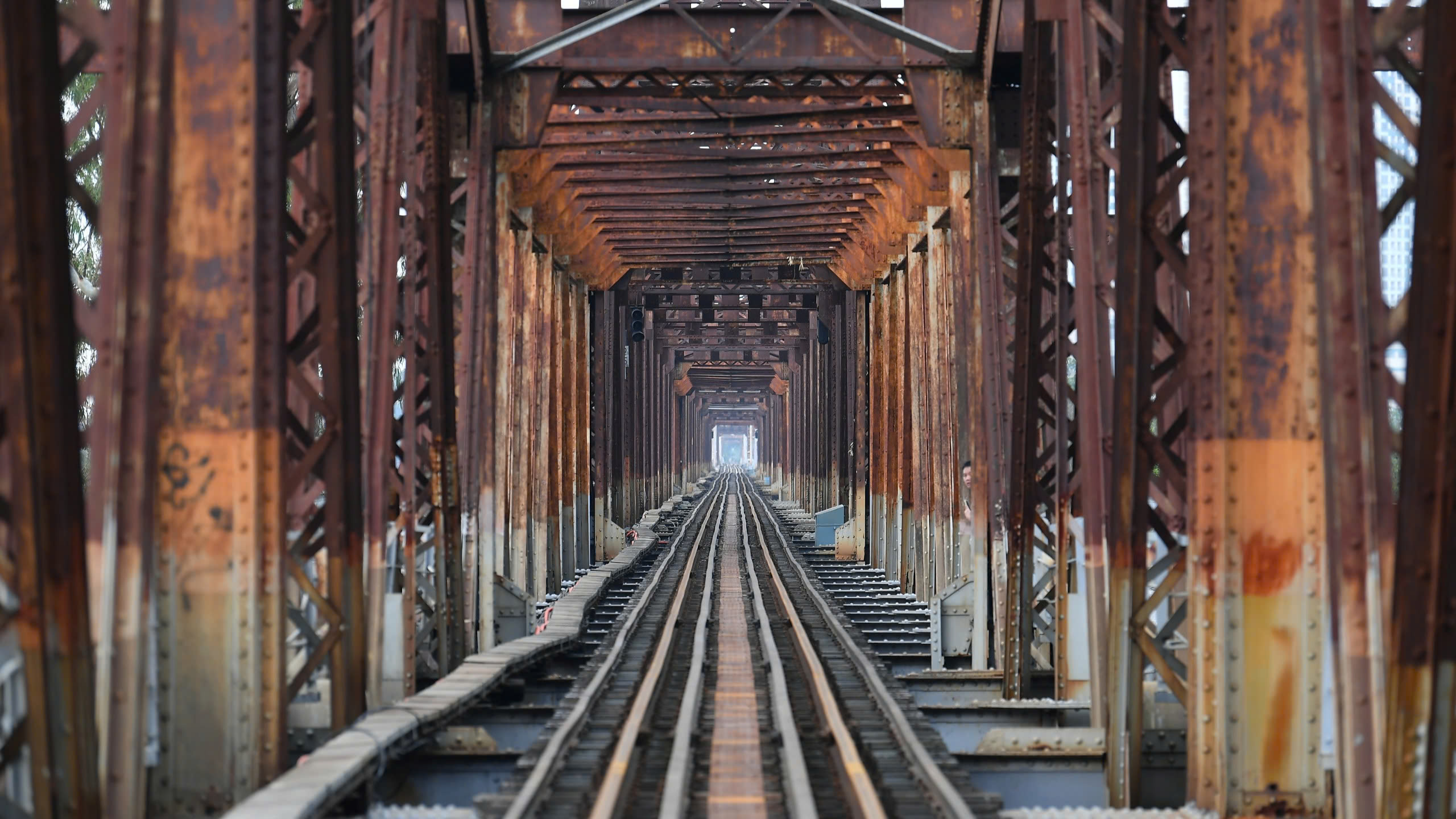
From the first rails…
On July 20, 1885, the first train whistle sounded on the Saigon-My Tho route, marking the moment when the Vietnamese railway industry officially appeared on the regional traffic map.
Since then, over nearly 150 years, the railway has been closely associated with the ups and downs of the country – from the colonial period, through two resistance wars, the post-war recovery period, to the renovation and integration process.
Back in 1881, the Saigon-My Tho railway line was officially started with a length of more than 70km and a total cost of nearly 12 million Francs. In addition to the two main stations of Saigon and My Tho at the two ends of the line, there were 18 stops including 2 main stations, 11 sub-stations and 5 stops.
This was the first railway section established in Vietnam as well as in Indochina, and the second railway section in the entire French colonial system at that time, after the first section of nearly 13km long located in Pondichéry - a French trading post in India, which began operating on December 15, 1879.
Although it was inaugurated on October 30, 1982, it was not until 3 years later, on July 20, 1985, that the Saigon-My Tho railway officially came into operation, marking the formation of the Vietnamese railway industry. In 1936, the trans-Vietnam railway was put into operation, marked by the event on September 2, when the railway from Hanoi to and from Saigon was connected at the railway section located in the Hao Son area (former Phu Yen province), 1km south of Hao Son station.
After more than 50 years, the Vietnam railway network was completed with a total length of 2,600km across the three regions of the country, nearly 37 times longer than at the beginning, establishing the earliest and most synchronous railway system in Southeast Asia at that time. In the following years, the railway network continued to be built throughout Vietnam using French railway technology with a 1m gauge.
Although the formation of the railway industry is closely linked to the exploitation and exploitation process of French colonialism and has always been used by the ruling forces as a tool and an effective means to serve their intentions of invasion and domination, right from the moment the first sleepers and rails were laid on this land, the railway has also been closely linked to the sweat, effort and blood of generations of Vietnamese workers, of the Vietnamese people and has become a historical product of the country of Vietnam.
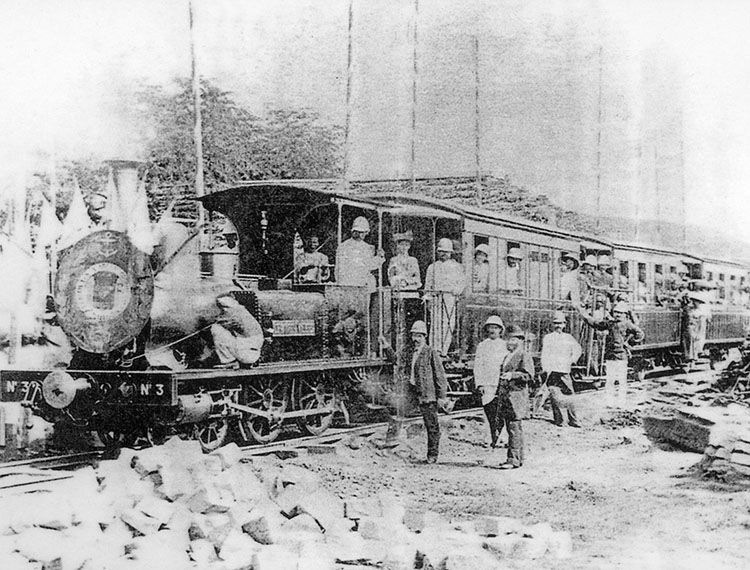
The first train in Indochina from Saigon to Cho Lon on December 27, 1881.
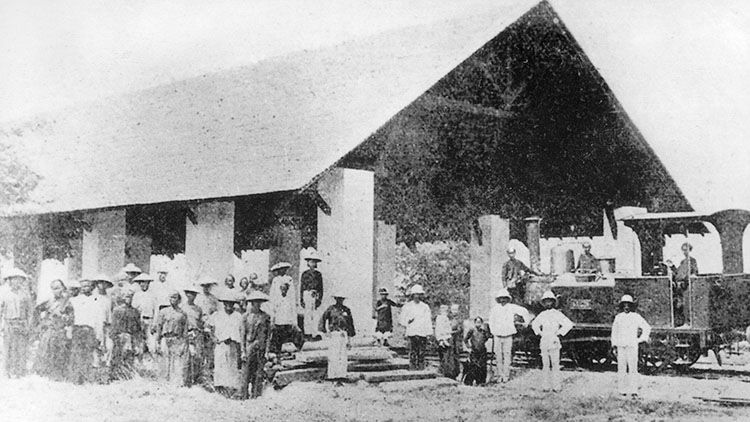
Saigon Railway Station was built in 1881.
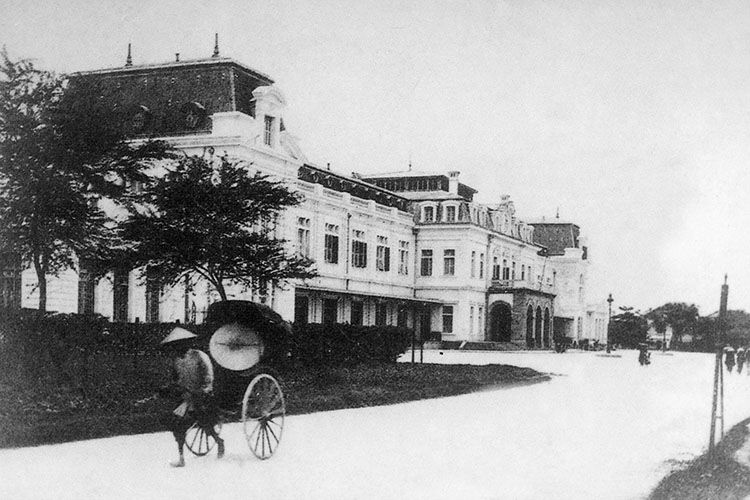
Hanoi Railway Station before 1927 (front).
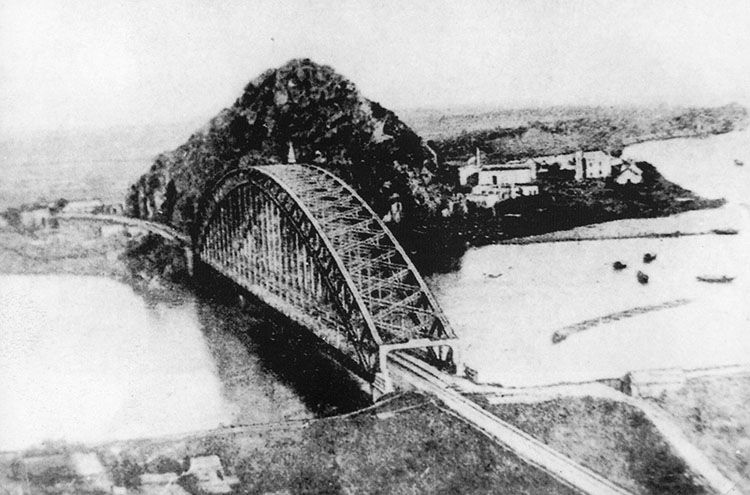
Ham Rong Bridge on the trans-Vietnam railway was built and put into use in 1904.
...to witness in national history
During the resistance war against French colonialism, Vietnam's railways actively served the struggle against internal and external enemies, especially in supporting the Southern army and people in the resistance war.
In late 1945 and early 1946, day and night, trains hurriedly welcomed and transported troops from localities to the South to fight against the French invaders. Carrying red flags with yellow stars, pictures of President Ho Chi Minh , banners and slogans such as "Support the Southern Resistance", "Vietnam Independence", "Down with French Colonialism", "The Southern Region is Vietnam's Land", the trains carrying cadres and soldiers to the South stopped at many stations to receive more troops and to receive food, water and snacks from the local people.
The march to the South was the image of the whole country going to war and the stations and trains on the Hanoi-Nha Trang line were the places where that image was vividly and heroically expressed. Since November 1945, the Ministry of National Defense and the railway industry had organized dozens of trains, carrying thousands of tons of rice and more than 4,000 blankets, 8,000 square meters of khaki fabric and many weapons, ammunition... to supply the soldiers and people in the front lines.
The effective support in terms of human resources, material resources, and timely political and spiritual encouragement from the North and Central regions, demonstrated through the Southern advance movement, had a great effect on the steadfast resistance of the Southern army and people, stopping the French army's advance to the North. In early 1946, the French army had to stop at the southernmost tip of the Central region, unable to attack quickly, win quickly, and annex our whole country as they had originally planned. The Northern and Central railways participated from the beginning to the end of the frontline support activities, contributing worthily to the victory of our army and people on all fronts. This was a great achievement of the Vietnamese railways to the Fatherland, since the day the railways belonged to the people and the revolutionary State.
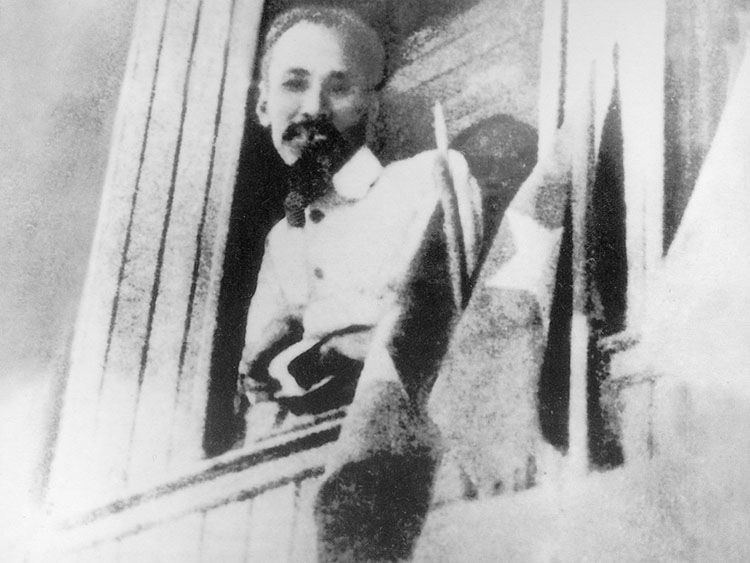
Uncle Ho on the train from Hai Phong to Hanoi on October 21, 1946.
October 21, 1946 marked a historic milestone for the railway industry when it was honored to welcome President Ho Chi Minh on a special train from Hai Phong to Hanoi after a 5-month visit to France. Fully aware of their heavy responsibility, railway officials and employees, from the Railway Department to those directly on duty at the stations and on the train, tried their best, coordinated with relevant sectors, with local Party committees, authorities and people to bring President Ho Chi Minh and many other high-ranking leaders of our Party and State back to the capital absolutely safely and on schedule.
In response to the great devotion and sense of responsibility of the railway workers, on November 18, 1946, President Ho Chi Minh sent a letter of thanks and commendation, in which he wrote a touching passage: “The railway work is an important work in the construction of the country. I hope that the railway workers will always unite and strive to fulfill their duties.”
Those thoughtful and profound words of advice have become the guiding principle for the entire railway industry throughout the journey of construction, development and dedication to the country. From that proud mark, October 21, 1946 has been remembered as a special milestone in the history of the Vietnamese railway industry. In accordance with the legitimate wishes of many generations of railway officials and employees, on March 11, 1996, the Prime Minister signed a decision to make October 21 every year the Traditional Day of the Vietnamese Railway Industry - a solemn recognition of the industry's great role and contribution in the cause of building and defending the Fatherland.
During the years of resistance against French colonialism, Vietnam’s railways suffered heavy losses in both infrastructure and human resources. However, despite numerous difficulties, railway workers remained steadfast, joining the entire nation in the resistance, while gradually preparing the necessary conditions for the restoration of the railway system in the future.
After peace was restored with the signing of the Geneva Agreement (July 20, 1954), the railway industry made a miracle in the process of restoring and building the country. With the plan: quickly opening, opening first then supplementing later, thoroughly taking advantage of old materials and locally available materials, mainly restoring but combining with improvement..., within just 4 years (1954-1957), a series of vital railway lines were completely restored such as Hanoi-Muc Nam Quan (1955), Yen Vien-Lao Cai (1956), Van Dien-Ninh Binh-Ham Rong (1959)... The industry quickly took over, managed and exploited more than 662km of railway, ensuring the safe transportation of hundreds of millions of tons of goods and millions of passengers, playing an important role in the process of healing the wounds of war and building the country.
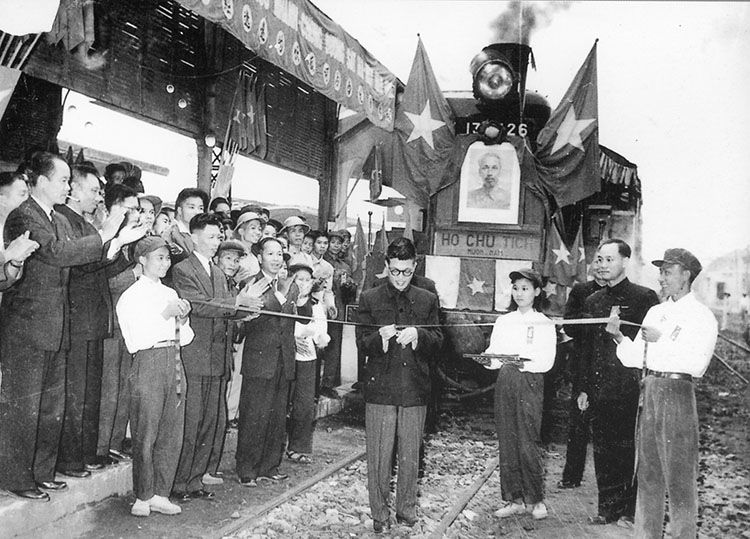
On December 31, 1955, Minister of Transport and Post Nguyen Van Tran cut the ribbon to inaugurate the Hanoi - Nam Dinh railway section.
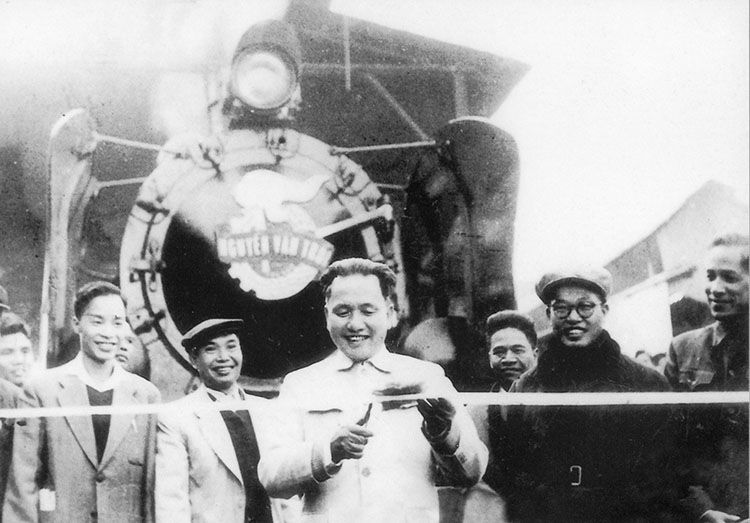
On December 18, 1964, Deputy Prime Minister Le Thanh Nghi and leaders of the Ministry of Transport and the General Department of Railways cut the ribbon to inaugurate the "Tu Luc" locomotive named Nguyen Van Troi, manufactured by the staff and workers of Gia Lam Railway Factory.
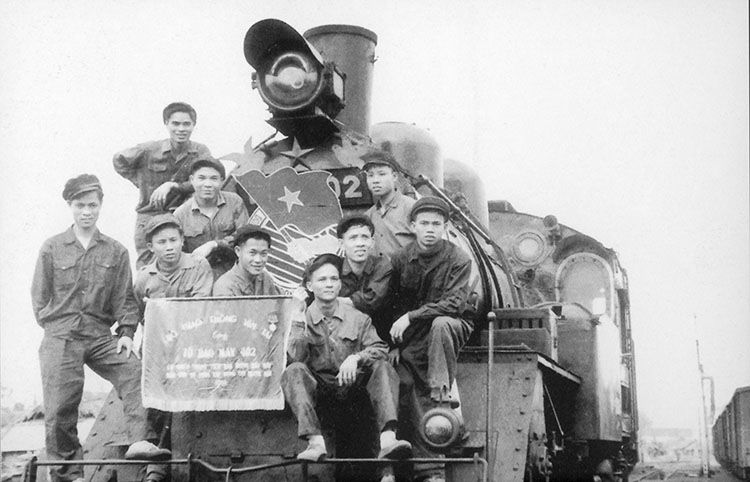
Thanh Nien 402 engine crew - Labor Hero collective, has many achievements in safe train operation and fuel economy.
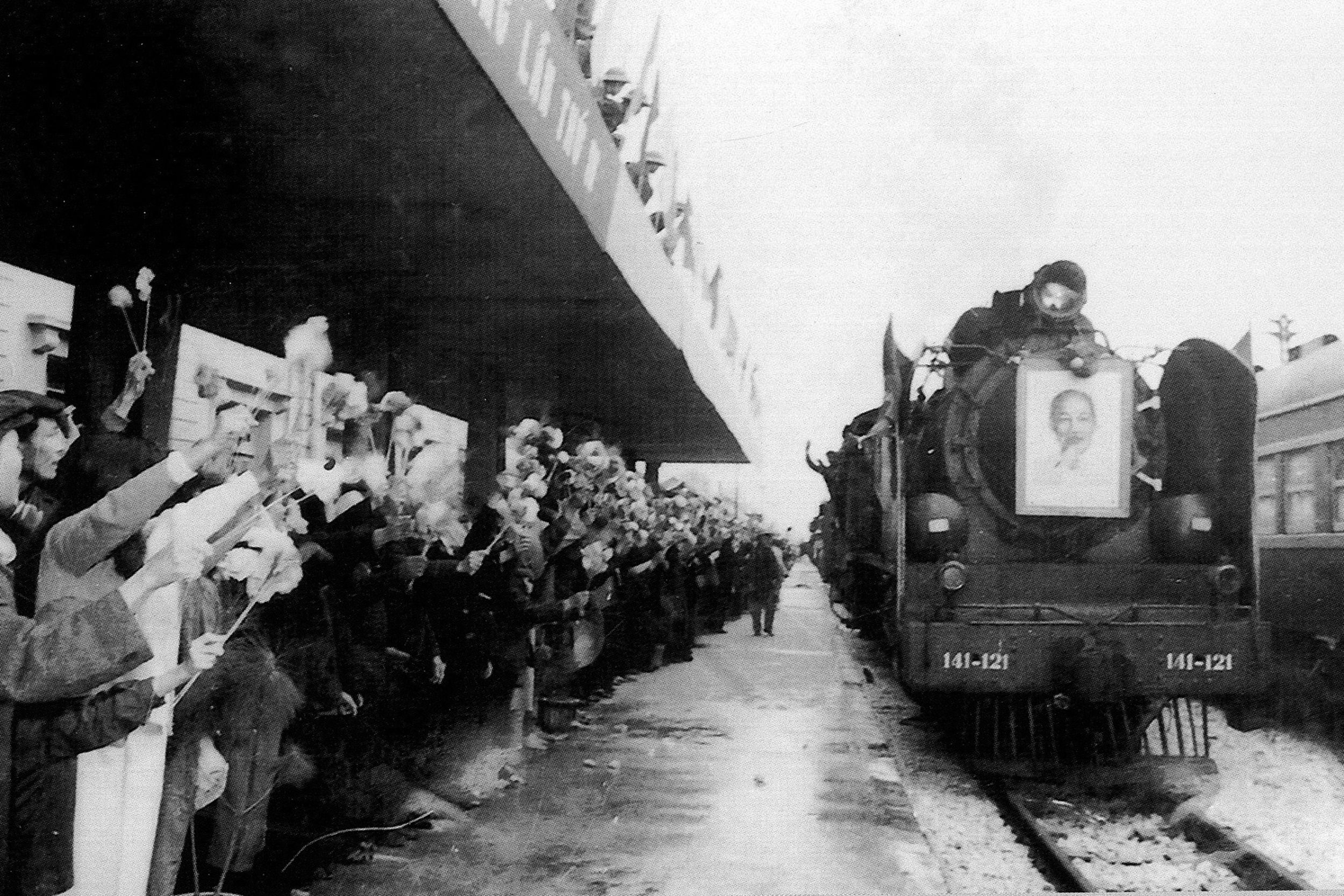
Steadfast in nation building
During the 10-year period (1954-1964), the Northern railway system was built and restored with main routes such as Hanoi-Lao Cai, Hanoi-Hai Phong, Hanoi-Lang Son. These are all vital routes, playing an important role in serving the travel needs and restoring the northern economy after the war. At the same time, the 57km-long Hanoi-Thai Nguyen route was also completed, contributing to completing the railway network in the northern midland region. In particular, the railway industry began to take shape with a number of technical specialties, although still limited, but initially self-produced a number of products for internal use. A typical example is the development of the Gia Lam Railway Factory - one of the important foundations that laid the foundation for the Vietnamese railway industry later.
During the resistance war against the destructive war in the North and to support the South, with the spirit of "All for the front line", "Living to cling to the bridge, clinging to the road, dying steadfastly and bravely", "If the enemy destroys us, we will repair it, if the enemy destroys us, we will keep going", railway officers and workers had many unique innovations in ensuring railway traffic, such as: a combined ferry bridge across the Red River, a swing bridge to hide motorbikes; creating the famous mode of transport "crossing the river without a bridge, running the train without a station" to break the monorail and monorail; organizing transport by trolley on the southern railway and the fire line of zone 4, expressing noble revolutionary sentiments: "a broken bridge is like a broken bone, a broken road is like a broken intestine". The fighting spirit was raised by the movement of "singing to drown out the sound of bombs"; organizing train operations while arranging forces to fight against American planes.
"The trans-Vietnam railway line was officially reconnected, becoming a strong symbol of the spirit of solidarity, unification and aspiration of the entire nation after the day the country was reunited."
Overcoming all sacrifices and losses, the entire industry transported millions of tons of goods, military equipment, millions of soldiers, youth volunteers, and militiamen to serve the southern battlefield to fight the Americans until the day of total victory. After the country's reunification, implementing the Party and State's policies, the Party Committee led the entire industry to overcome countless difficulties and shortages, mobilized maximum human resources and labor resources to restore and renew 20km of bridges, 520 culverts, laid 660km of new railways, 1,686km of communication lines, dug and filled nearly 3 million cubic meters of soil, and on December 31, 1976, inaugurated the 1,729km-long Thong Nhat railway. The trans-Vietnam railway was officially reconnected, becoming a strong symbol of the spirit of solidarity, the will to unify and the aspiration to rise of the entire nation after the country was reunited.
Rising up in the Renovation process
During the years of innovation, the railway industry was one of the units that promptly and effectively implemented the reorganization of production, invested in upgrading infrastructure, gradually equipped with modern means, improved management mechanisms, promoted a dynamic and creative spirit, and achieved many outstanding achievements.
On May 1, 1990, the General Department of Railways (established under Decree No. 505 dated April 6, 1955 of the Prime Minister) was transformed into the Vietnam Railway Union (under Decision No. 575 of the Ministry of Transport), opening an organizational model suitable for the new mechanism.
To improve the efficiency of transport exploitation, shorten the time of delivery, receipt of goods and transportation on the road, Vietnam Railway Union has researched and changed the method of managing and organizing train operations, decentralizing train operation management into routes: short-distance, medium-distance and long-distance, in which priority is given to long-distance freight transport to increase output and revenue.
An important innovation goal of the railway industry is to improve the quality of passenger service, first of all, shortening train running time and ensuring safety, upgrading equipment, enhancing responsibility and respect for passengers. The industry organizes light, fast, comfortable trains to serve passengers on the Hanoi-Hai Phong and Saigon-Nha Trang routes.
With a spirit of initiative and creativity, the Railway Union has proactively combined upgrading bridges, locomotives, and wagons with streamlining technical operations and train safety. The North-South unified train journey when it was first restored (in 1976) was 72 hours, in January 1988 it was reduced to 60 hours, in September 1989 to 48 hours, in May 1991 to 42 hours, in May 1993 to 38 hours, in April 1994 to 36 hours, showing clear effectiveness in improving operational and service capacity.
The period 1996-2000 witnessed a strong development of the railway industry, with impressive growth in output and revenue. The volume of converted ton-km increased by an average of 6.48% per year, and revenue increased by 13.53% per year. In 2000 alone, the output of goods reached over 6.1 million tons, with total revenue exceeding 1,252 billion VND, equal to 124.05% compared to 1999. This was the year with the highest growth and revenue in 10 years of innovation (up to 2000) of the railway industry.
In particular, since September 2000, two pairs of express trains S1/S2 and S3/S4, jointly designed and manufactured by officers and workers of railway car factories in the industry, have been put into operation, opening a new step in improving service quality and meeting the increasing travel needs of the people.
Transport output in nearly 7 years (1995-2001) increased by an average of 9.58%/year, of which in 1995, the productivity reached 1 billion 735 million tons/km of goods, 2 times higher than in 1990. International cooperation in the industry continued to expand. On February 14, 1996, at Dong Dang, Lao Cai stations (Vietnam) and Bang Tuong, Son Yeu stations (China), the Government and railway industry of the two countries solemnly held a ceremony to restore the Vietnam-China railway. In May 1996, in the Philippines, Vietnam Railways joined the ASEAN railway organization.
Transport output in nearly 7 years (1995-2001) increased by an average of 9.58%/year, of which in 1995, the productivity reached 1 billion 735 million tons/km of goods, 2 times higher than in 1990.

The first Chinese train arrived at Dong Dang station (Lang Son) on the morning of February 14, 1996, at the Vietnam-China railway restoration ceremony at the two border gates of Lang Son and Lao Cai, after 17 years of interruption. Photo: VNA
The goal of shortening train travel time continues to be implemented in a cautious, sure and safe manner. In 2000, the Thong Nhat train journey was 32 hours, in 2005 it reached and maintained 29 hours and 30 minutes. The Hanoi-Hai Phong train journey was reduced from 3 hours to 2 hours, Hanoi-Lao Cai from 10 hours to over 7 hours, Hanoi-Dong Dang from 7 hours to under 5 hours.
On March 4, 2003, Vietnam Railways Corporation was established on the basis of Vietnam Railways Union according to Decision No. 34 of the Prime Minister, with the task of doing business in railway transport, domestic multimodal transport and international intermodal transport; managing, exploiting, maintaining and repairing the national railway infrastructure system... The Corporation officially came into operation on July 1, 2003. The process of reorganizing and converting Vietnam Railways Union into Vietnam Railways Corporation is also the process of the railway industry innovating the entire internal management mechanism system, both expanding production and business of multiple products, and implementing multiple ownership, proactively competing equally in the market mechanism.
In particular, in May 2004, the National Assembly of the Socialist Republic of Vietnam passed the Railway Law, laying a solid legal foundation for sustainable development and comprehensive modernization of the railway industry in the following stages.
In May 2004, the National Assembly of the Socialist Republic of Vietnam passed the Railway Law, laying a solid legal foundation for sustainable development and comprehensive modernization of the railway industry in the following stages .
Innovation in thinking...
Since its inception, through the wars of national defense and the journey of building peace, the railway industry has always been firmly on the front line, an important means of transport in the economic development and national security and defense of our country. However, over the years, the infrastructure of the railway system has fallen behind the development of the world's railways. This is reflected in the low level of infrastructure, single railways account for 85% of the country's railway transport system while the transport capacity is limited, has become old, and has not been built and developed.
Currently, Vietnam's railways are still mainly small gauge (1,000 mm), while most countries in the world no longer use them. Train speeds in our country are only about 50-60 km/h for freight trains, and about 80-90 km/h for passenger trains. In developed countries in the world, the average passenger transport speed is about 150-200 km/h, not to mention high-speed railways of more than 300 km/h, or even higher.
The proportion of railway transport has decreased sharply, accounting for only 1-2% of the total transport volume of the country. Meanwhile, the budget for infrastructure maintenance is often insufficient compared to the demand, leading to a "patchwork" situation when repairing... The shortcomings and limitations of the railway industry have been frankly acknowledged by the Government when summarizing 10 years of implementing Conclusion 27-KL/TW dated September 17, 2008 of the Politburo on the Strategy for developing Vietnam's railway transport to 2020 and vision to 2050.
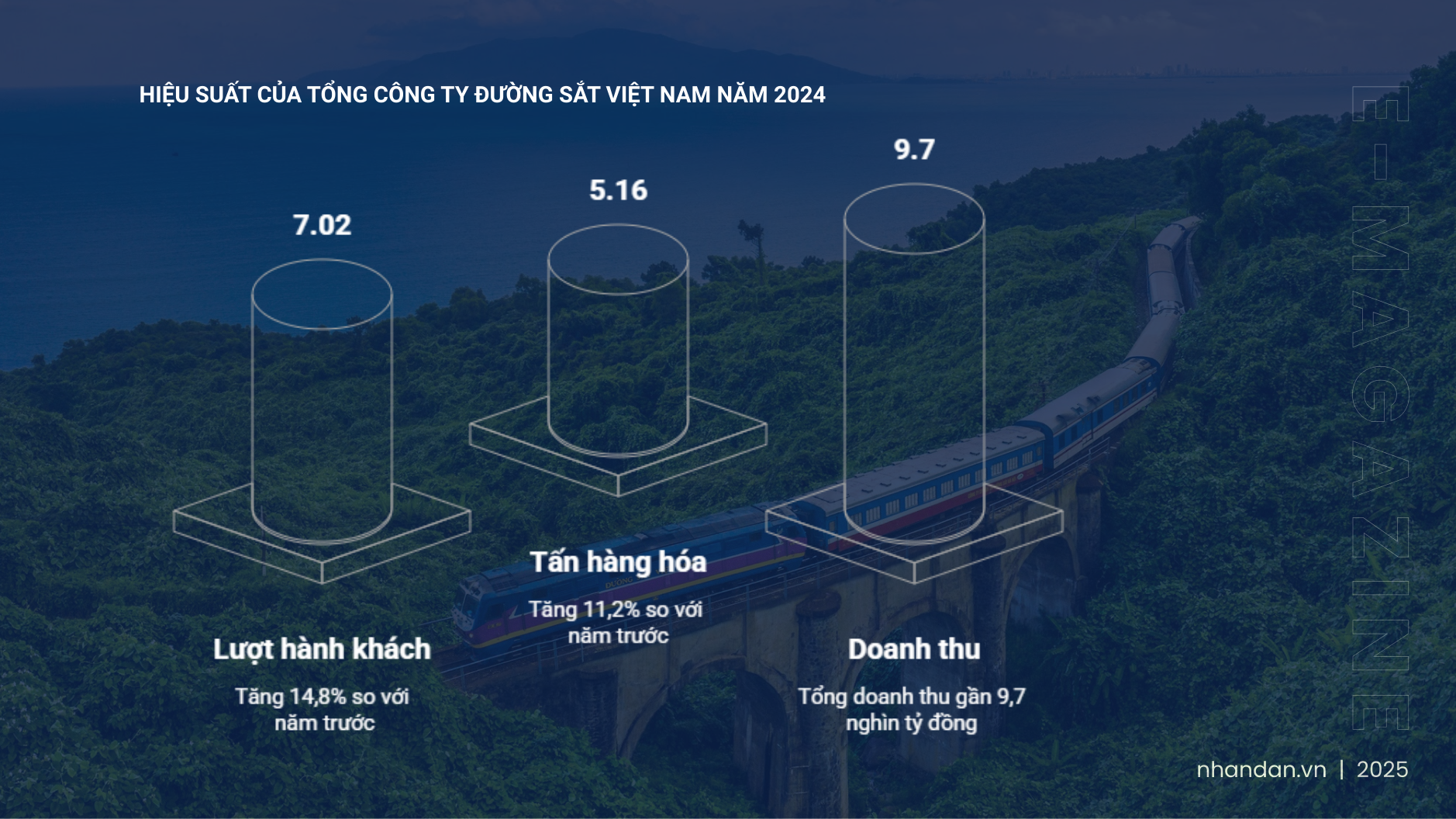
On February 28, 2023, the Politburo issued Conclusion No. 49-KL/TW on the orientation for the development of Vietnam's railway transport to 2030, with a vision to 2045, clearly stating the unified perception of the entire political system on the position, role, importance, and necessity of railway transport.
Accordingly, it is determined to develop modern and synchronous railway transport to promote rapid and sustainable socio-economic development. Railway transport plays a key role in the north-south economic corridor, the main east-west transport corridors and passenger transport in major cities. This can be seen as a "starting shot" to revive a transport method with many advantages, but is slow to innovate and outdated.
Faced with the great concern of the Party and the State, as well as the practical requirement to improve the operating methods to enhance competitiveness, the Vietnamese railway industry has innovated its business thinking: from focusing only on what the industry has to serving what the market, society and people need. This is considered a strong breakthrough, creating new growth momentum, significantly changing the image of the railway industry.
At the conference to deploy production and business tasks in 2024 of Vietnam Railway Corporation, Prime Minister Pham Minh Chinh expressed his impressions of the changes in the railway industry, and at the same time expressed his desire to revive and develop this industry sustainably, worthy of being a key mode of transport.
"With the same assets, the same people, the same policy mechanism, but with a new way of doing things, a new way of thinking, and changes in management and operation, the quality and efficiency achieved by the railway industry have clearly changed. When boldly breaking the "iceberg" of old, outdated thinking, the industry will certainly overcome the difficulties and obstacles that have held it back for so long."
Prime Minister Pham Minh Chinh
“With the same assets, the same people, the same policy mechanism, but with new ways of doing things, new thinking, changes in management and operation… the quality and efficiency achieved by the railway industry have clearly changed. When boldly breaking the “iceberg” of old, outdated thinking, the industry will certainly overcome the difficulties and obstacles that have held it back for so long,” the Prime Minister emphasized.
With the goal of improving service quality and focusing on passengers, in recent times, the railway industry has invested in installing waste treatment systems on passenger cars, renovating platforms, building roofs at Hanoi and Saigon stations and overpasses in Hanoi station... Vietnam Railways Corporation has also synchronously implemented many measures to improve service, bringing a fresher and more modern image of passenger transport. In particular, the application of science and technology to electronic ticket sales helps passengers easily access services anytime, anywhere, with flexible and convenient payment methods.
... efforts to overcome difficulties to break through
With an impressive transformation, after three years of losses, in 2023, Vietnam Railways Corporation made a profit of nearly 100 billion VND. In 2024, despite being heavily affected by natural disasters and storms and floods, the Corporation still achieved positive results, exceeding the plan in terms of passenger volume (7.02 million, up 14.8%) and cargo (5.16 million tons, up 11.2%), with total revenue reaching nearly 9.7 trillion VND.
Entering a new stage of development, the mission of the railway industry is now not only a means of transportation, but also brings special experiences, helping tourists discover the natural beauty, culture and history of each land, becoming a journey to discover the beauty of the country's heritage.
Efforts to build products and services have helped the railway industry create a "transformation" in image and brand. At Long Bien station (Hanoi), when renovating and turning a part of the station into "Railway Cafe", after a short time, the name appeared on the Hanoi tourism map. The "Train Road - Flower Road" movement with the motto "Each route has a flower, each station has a destination" has given a new, colorful coat to the routes and stations stained with time.
Last year, Vietnam Railways Corporation "introduced" a series of new products, which were highly appreciated by tourists and people. At the end of March, VNR put into operation the high-quality tourist train SE19/20 (Hue-Da Nang) named "Connecting Central Heritage". Passengers can "check-in" Hai Van Pass - "the most majestic pass in the world", and can watch the sunrise and sunset on Lang Co Bay, one of the most beautiful bays in the world. In mid-April, the unit continued to launch the "Da Lat Night Journey" train Da Lat-Trai Mat to bring passengers new experiences, feeling the beauty of Da Lat at night. This is the only unique cog railway line in Vietnam serving tourists visiting Da Lat city. The passenger train SE21/22 was also selected by the Corporation to upgrade, renovate, and put into operation to serve passengers on the Saigon-Da Nang route. For the first time, on the train, VNR renovated and expanded the toilet (from 1m to 1.4m), completely replaced the interior. In addition to the 4-bed train, the train also has a number of 2-bed compartments to serve passengers who want private space.
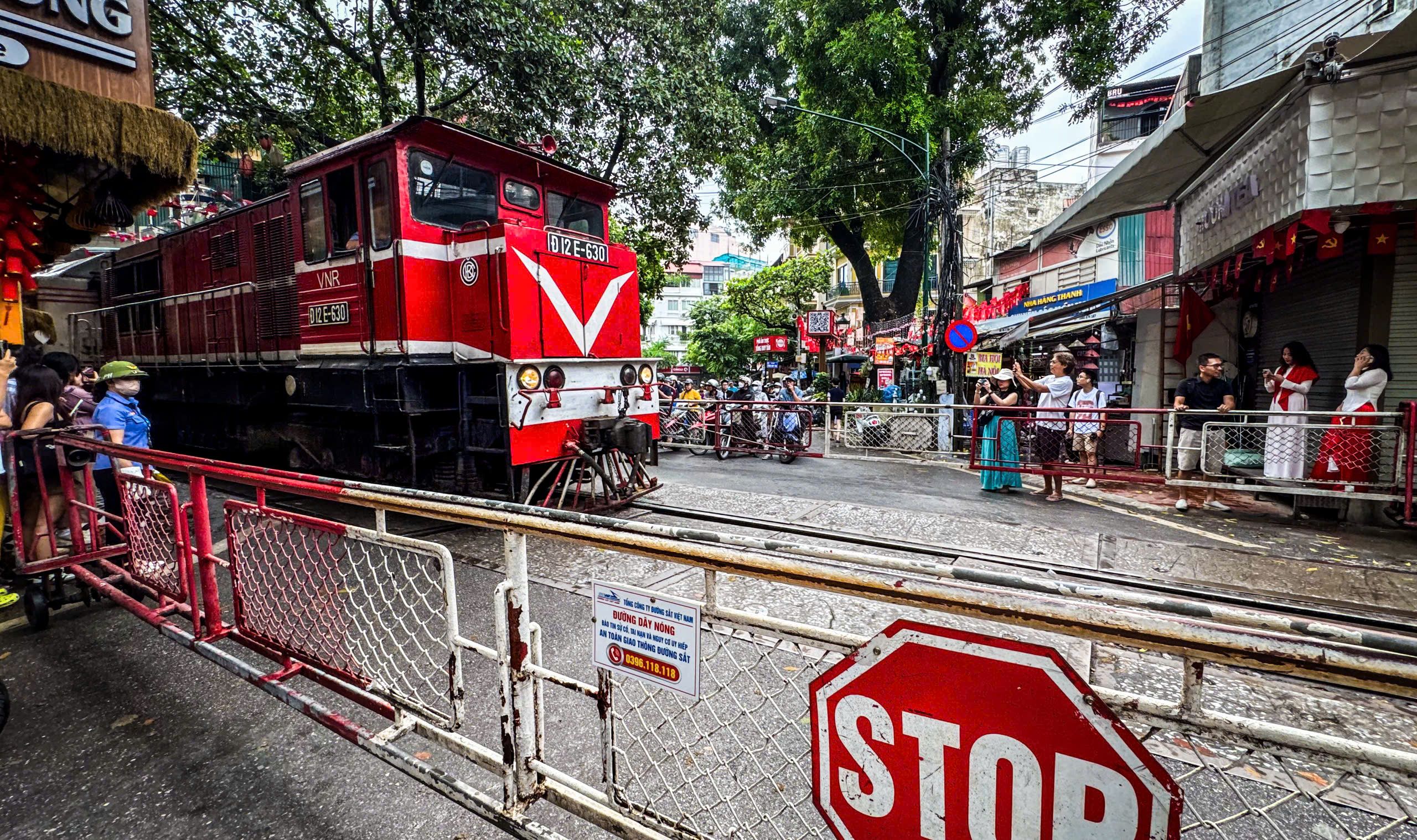
Train passes through Hanoi's downtown. Photo: Thanh Dat
Nhandan.vn
Source: https://nhandan.vn/special/lichsuduongsatvietnam/index.html#section-Above-the-Worlds-Edge-px80LZDp4D



![[Photo] Keep your warehouse safe in all situations](https://vphoto.vietnam.vn/thumb/1200x675/vietnam/resource/IMAGE/2025/10/1/3eb4eceafe68497989865e7faa4e4d0e)
![[Photo] President of the Cuban National Assembly visits President Ho Chi Minh's Mausoleum](https://vphoto.vietnam.vn/thumb/1200x675/vietnam/resource/IMAGE/2025/10/1/39f1142310fc4dae9e3de4fcc9ac2ed0)

![[Photo] Hanoi morning of October 1: Prolonged flooding, people wade to work](https://vphoto.vietnam.vn/thumb/1200x675/vietnam/resource/IMAGE/2025/10/1/189be28938e3493fa26b2938efa2059e)

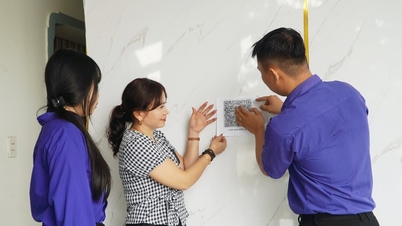



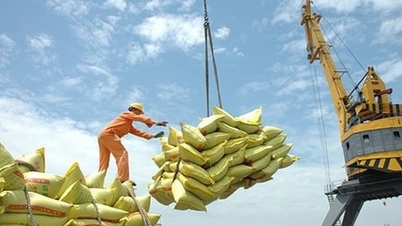

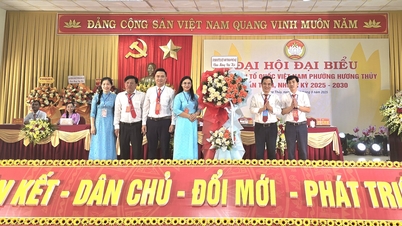

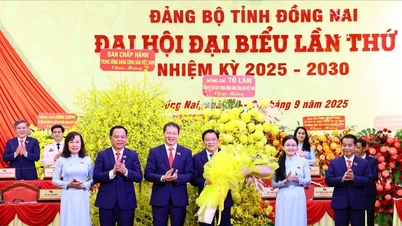



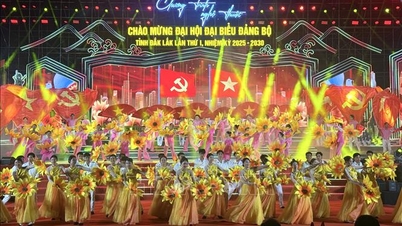
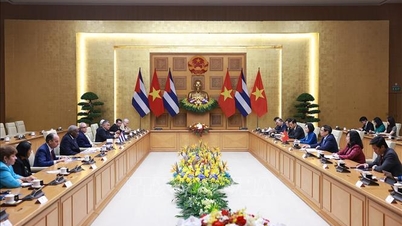
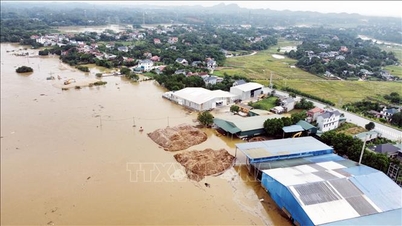
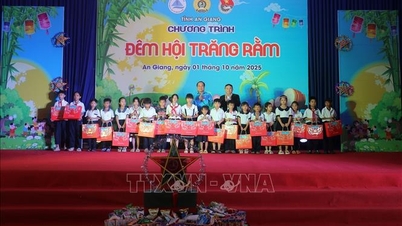
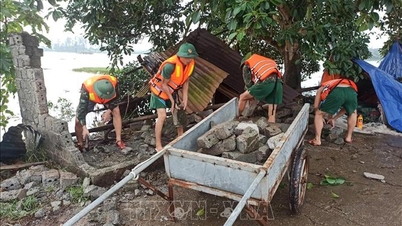
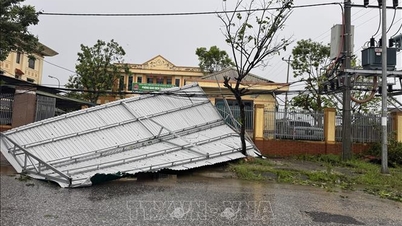





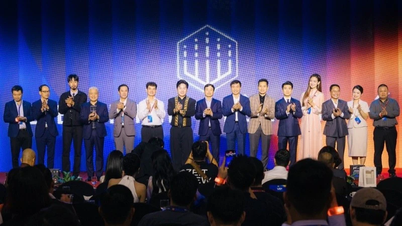
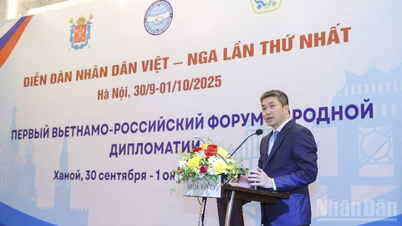
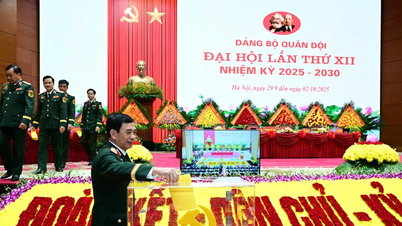
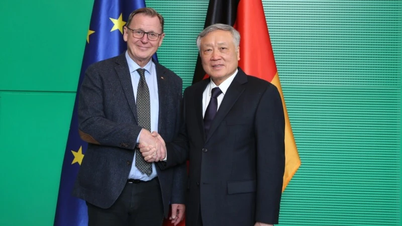
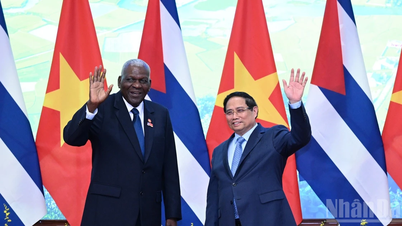
































































Comment (0)